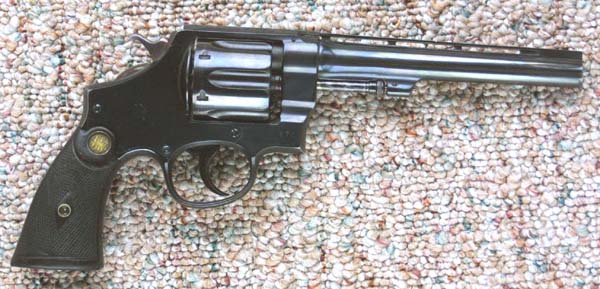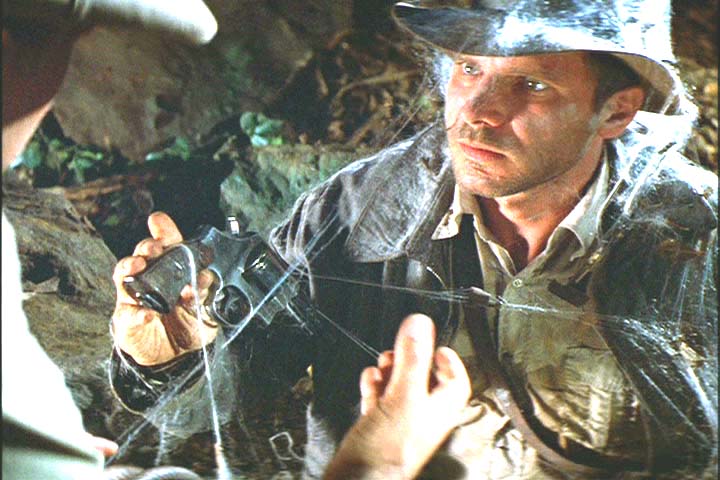 M-1917(S&W)
M-1917(S&W)
| Length overall | Barrel Length | Weight | Caliber | Action Type | Magazine Capacity |
| 10 3/4 " | 5.5" | 36 oz. | .45 A.C.P./45LC | D.A. Revolver | 6 |
 This is the oldest gun I own, and it is a classic. The
S&W version of the M-1917, chambered for the .45 Auto Cartridge. This
gun, and it's Colt counterpart were produced during WWI because the Colt
plant could not produce enough of it's excellent and, at that time, cutting
edge automatic pistols to arm the troops for trench warfare. Colt and S&W
were both capable of producing large quantities of revolvers, and the Army
decided to use these guns to supplement the short supply of autos, provided
the manufacturers would chamber them for the new .45 A.C.P.cartridge in
order to simplify logistics. In some ways this was a better gun for the
job, as the man of that day was more likely to be familiar with a revolver
than an automatic. A revolver is also unaffected by ammunition quality and
is not slowed down by a misfire as an auto pistol might be. It is also
somewhat more tolerant of neglect and abuse, and less likely to
be affected by dirt, and mud.
This is the oldest gun I own, and it is a classic. The
S&W version of the M-1917, chambered for the .45 Auto Cartridge. This
gun, and it's Colt counterpart were produced during WWI because the Colt
plant could not produce enough of it's excellent and, at that time, cutting
edge automatic pistols to arm the troops for trench warfare. Colt and S&W
were both capable of producing large quantities of revolvers, and the Army
decided to use these guns to supplement the short supply of autos, provided
the manufacturers would chamber them for the new .45 A.C.P.cartridge in
order to simplify logistics. In some ways this was a better gun for the
job, as the man of that day was more likely to be familiar with a revolver
than an automatic. A revolver is also unaffected by ammunition quality and
is not slowed down by a misfire as an auto pistol might be. It is also
somewhat more tolerant of neglect and abuse, and less likely to
be affected by dirt, and mud. Revolver cartridges need a rim to extract; auto pistol cartridges use a groove near the base. In order to use the .45 auto cartridge in these guns, a small piece of stamped metal called a half moon clip was developed. Each one holds three rounds, and two were used to load the pistol. Loaded in such a fashion, these guns could be emptied and recharged almost as fast as the auto for which they were substituted. Today we have full moon clips which hold six rounds so that this revolver can be charged as quickly as an auto. Full moon clips are cheap, and readilly available. I have an even dozen of them, and have found that I can easilly carry four loaded full moon clips in a dual speedloader holder. This gives me 24 rounds of ready loaded ammunition which only takes up a small amount of space on my belt.
I have also fired .45 Long Colt cartridges through this gun, although, not wanting to be sued, I will not recommend the practice. At any rate, the .45 Auto rounds are ballistically the same as the .45 Long Colts in normal loadings, so
There are a numbe rof custom gunmakers out there, who will convert standard caliber revolvers to accept a new version of full moon clips. These conversions are qut9ie popular with competition shooters, for the extra speed that they offer. I am aware of conversions in 357, and 44 magnum, though there may be others. The guns need only slight modifications, involving the carefull machining of the back of the cylinder. I slight bit of material is removed, allowing for the clearance of the cartridge head with the moon clip. One very popular conversion of this type, is performed upon the new eight shot versions of the model 629. In this respect the old 1917 was nearly a century ahead of it's time.
This gun was based upon the .44 hand ejector of 1908. This eventually was developed into the respected S&W "N" frame upon which the famous M-29 .44 Magnum of Dirty Harry fame was built. This is also the same frame that is used in the M-27, which was the original .357 magnum back in the thirties. Today a version of the M-1917 is still made by S&W. It is updated and modernized, and called the Model 25-5, but deep down inside it is a M-1917. The modern guns have been made available in both nickel, and stainless versions, in addition to the classic blue finish. They also have the more modern extractor rod shroud, in keeping with the rest of the S&W revolver line. The gun goes in and out of production depending on demand. Although the same cylinder is used in these guns as in the .44 Magnum, they can not be hot loaded. The .44 magnum is actually a .429 bore, whereas the .45 is a .452 bore. The extra .023 inch is the difference between a safe revolver and a blown cylinder. The gun has fair accuracy with the .45 A.C.P., shooting between 3 and four inches. I prefer not to mention how it shoots the old .45 L.C. Suffice it to say that the groups are a bit larger with the older cartridge. A number of model 1917 revolvers were converted to properly fire the 45 L.C. A large number of these guns were chambered in .455 caliber, and sent over to the British for use in World War One.
After the war some of these guns went down to South America, to serve in Brazil, where they aquired a rather attractive Brazilian government crest. Many were
This is one of the old five screw Smiths, and is presently the only five screw S&W revolver that I own. The five screw models are somewhat sought after, in part because they are the older models; but also because some shooters regard them a bit more highly than the following four screw, and three screw models. The uppermost screw was done away with, as well as the screw at the front of the trigger guard, which is not visable in the photo.This is the second model hand ejector, introduced to replace the famed triple lock.It origonally came with a set of old diamond pattern grips, which are almost comically small on the huge frame. These grips are of walnut, and have some rather fancy gilt monograms. There are aome other details on this gun, which make it seem a bit fancy, by today's standards. They did do things differently 100 years ago. I have replaced the grips with a set of larger combat grips, and will eventually get a set of rubber reverse wedge grips. The action is smooth enough, but history and nostalgia aside, it is not as good as most of my newer N frame revolvers. It should come as no surprise that the premier revolver maker had advanced the design over the years. The barrel is tapered, and rather light by today's standards. In those pre magnum, early smokeless powder days, it was neither necessary nor desirable to install the type of heavy
 barrel favored today. A photo of the gun, as I recieved it, is shown to
the left, old grips and all.
barrel favored today. A photo of the gun, as I recieved it, is shown to
the left, old grips and all.As an aside, for those interested in firearms and the movies, this model was featured in the origonal Raiders of the Lost Ark. I have included a photograph of the actual gun used in the filming, which I captured from the movie. This was one of two S&W Hand Ejector models used in the filming of the movie. The other was the same model chambered for the .455 Ely. Both had their origonal barrels cut down to four inches,from the standard 5.5 inches, and were used interchangably in the movie. As with most of what comes out of Hollywood, it is difficult to know what the "real gun" was supposed to have been, since two slightly different models were used to play the role. I do note that Indiana Jones was never shown reloading this piece. Such a detail would have verified the particular model that he was supposed to have used; but it was never shown. The band at the front end of the barrel, was by no means standard, and may have simply been an armourers expedient used after cutting down the barrel on the gun used as a prop. This may have been a quick and dirty wat to afix a front sight, dispensing with the need for brazing or milling operations. In the latter movies in the series, different guns were used, including a Webly, Colt M1911, and Browning P-35 (High Power). For those interested, more information
 can be found at: http://www.indygear.com/gear/guns.shtml
A comparison of the movie capture, to the photo of my gun, with
it's origonal grips, shows them to be identical, except for the cut down
barrel.
can be found at: http://www.indygear.com/gear/guns.shtml
A comparison of the movie capture, to the photo of my gun, with
it's origonal grips, shows them to be identical, except for the cut down
barrel.Firearms, buildings, and ships, are about the only man made items which are able to survive for a hundred years, and still remain functional. There is something amazing about holding, and firing a gun which has been held and fired in historical engagements by men long gone. Even the men and factories which produced this pistol have passed from the world. This makes such an item a bit of a time capsule.
My particular example of this gun has no collectors value, since, like it's movie counterpart, it has been modified. In my case, the gun has had it's front sight removed, and has had a vent rib brazed to the top of the barel. I can only assume that this is for a previous owner who liked to fire shot shell loads through the piece. Like many other old guns out in circulation, this particular example has had many owners, since it left the military, and I will doubtless never know why the modification was performed or by whom. This tiny angle of mystery is a part of the fun of owning these older firearms.
